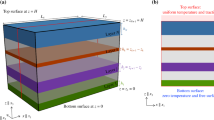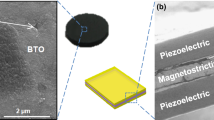Abstract
Non-uniform contact on the interphases of composites can model a wide variety of situations, ranging from delamination patterns with “islands” of contact to variable surface capacitance due to chemical reactions with the environment. In this work, the non-uniformity is modeled via spring-type imperfect contact conditions whose proportionality constants are functions of the position over the surface of contact. The effective thermo-magneto-electro-elastic coefficients of such a composite are studied via asymptotic homogenization. A modification of the ansatz of Bakhvalov is introduced on the global elliptic problem and the contact conditions in order to separate the global and local scales. This modification allows us to obtain families of local problems that are analytically solvable systems of ordinary differential equations whose solutions depend parametrically on the position variables of the contact surfaces. By integrating the local problems, analytical formulae for the functionally graded-like effective coefficients are obtained. The multiple coupled fields and associated moduli are organized through a matrix notation that facilitates the application of the asymptotic formalism and the derivation of the analytical formulae. The formulae are valid for any finite number of layers and anisotropies. Finally, some numerical examples are provided for composites with crystal symmetry 6 mm. One is related to the effective stiffnesses with a rectangular zone of delamination on the interphase. The second example shows the influence of some ideal non-uniform imperfect contact cases over the product properties of a thermopiezoelectric/thermopiezomagnetic two-phase composite.



Similar content being viewed by others
References
Aghdam, M.M., Falahatgar, S.R.: Micromechanical modeling of interface damage of metal matrix composites subjected to transverse loading. Compos. Struct. 66, 415–420 (2004). https://doi.org/10.1016/j.compstruct.2004.04.063
Atkins, A.G.: Intermittent bonding for high toughness/high strength composites. J. Mater. Sci. 10, 819–832 (1975). https://doi.org/10.1007/BF01163077
Berlincourt, D.A., Curran, D.R., Jaffe, H.: Piezoelectric and piezomagnetical materials and their function in transducers. In: Mason, W.P. (ed.) Physical Acoustics, pp. 169–270. Academic Press, New York (1964)
Bhowmick, S., Meléndez-Martínez, J.J., Lawn, B.R.: Bulk silicon is susceptible to fatigue. Appl. Phys. Lett. 91, 201902 (2007). https://doi.org/10.1063/1.2801390
Brito-Santana, H., Christoff, B.G., Mendes-Ferreira, A.J., Lebon, F., Rodríguez-Ramos, R., Tita, V.: Delamination influence on elastic properties of laminated composites. Acta Mech. 230, 821–837 (2019). https://doi.org/10.1007/s00707-018-2319-8
Caballero-Pérez, R.O., Bravo-Castillero, J., Pérez-Fernández, L.D., Rodríguez-Ramos, R., Sabina, F.J.: Homogenization of thermo-magneto-electro-elastic multilaminated composites with imperfect contact. Mech. Res. Commun. 97, 16–21 (2019). https://doi.org/10.1016/j.mechrescom.2019.04.005
Hadjiloizi, D.A., Kalamkarov, A.L., Metti, Ch., Georgiades, A.V.: Analysis of smart piezo-magneto-thermo-elastic composite and reinforced plates: part II-applications. Curved Layer. Struct. 1, 32–58 (2014). https://doi.org/10.2478/cls-2014-0003
Hashin, Z.: The interphase/imperfect interphase in elasticity with application to coated fiber composites. J. Mech. Phys. Solids 50, 2509–2537 (2002). https://doi.org/10.1016/S0022-5096(02)00050-9
Lee, J., Boyd, J.G., Lagoudas, D.C.: Effective properties of three-phase electro-magneto-elastic composites. Int. J. Eng. Sci. 43, 790–825 (2005). https://doi.org/10.1016/j.ijengsci.2005.01.004
López-Realpozo, J.C., Rodríguez-Ramos, R., Quintero-Roba, A.J., Brito-Santana, H., Guinovart-Díaz, R., Tita, V., Lebon, F., Camacho-Montes, H., Espinosa-Almeyda, Y., Bravo-Castillero, J., Sabina, F.J.: Behavior of piezoelectric layered composites with mechanical and electrical non-uniform imperfect contacts. Meccanica 55, 125–138 (2020). https://doi.org/10.1007/s11012-019-01111-2
Panasenko, G.P.: Homogenization for periodic media: from microscale to macroscale. Phys. At. Nucl. 71, 681–694 (2008). https://doi.org/10.1134/S106377880804008X
Sixto-Camacho, L.M., Bravo-Castillero, J., Brenner, R., Guinovart-Díaz, R., Mechkour, H., Rodríguez-Ramos, R., Sabina, F.J.: Asymptotic homogenization of periodic thermo-magneto-electro-elastic heterogeneous media. Comput. Math. Appl. 66, 2056–2074 (2013). https://doi.org/10.1016/j.camwa.2013.08.027
Zimmermann, E.A., Busse, B., Ritchie, R.O.: The fracture mechanics of human bone: influence of disease and treatment. Bonekey Rep. 4, 743 (2015). https://doi.org/10.1038/bonekey.2015.112
Acknowledgements
Financial support to this work was granted by projects FENOMEC and PAPIIT DGAPA UNAM IN10182. ROC received funding for his Ph.D. studies from CONACyT.
Funding
Funding is provided by Dirección General de Asuntos del Personal Académico, Universidad Nacional Autónoma de México (Grant No. IN10182), CONACYT (Grant No. PhD scholarship) and FENOMEC project.
Author information
Authors and Affiliations
Corresponding author
Ethics declarations
Conflict of interest
The authors declare that they have no conflict of interest.
Additional information
Publisher's Note
Springer Nature remains neutral with regard to jurisdictional claims in published maps and institutional affiliations.
Appendix: Existence and uniqueness of periodic solutions
Appendix: Existence and uniqueness of periodic solutions
Let \(\varvec{A}(y)\), \(\varvec{F}_0(y)\) and \(\varvec{F}_1(y)\) be 1-periodic matrix-valued functions of \(y\in \mathbb {R}\) of sizes \(s\times s\), \(s\times r\) and \(s\times r\), respectively. Suppose that the elements of \(\varvec{A}(y)\), \(\varvec{F}_0(y)\) and \(\varvec{F}_1(y)\) are piecewise differentiable in \(\left[ 0,1\right] {\setminus } \Gamma \) where
is the set of points of finite jump discontinuity of \(\varvec{A}\), \(\varvec{F}_0\) and \(\varvec{F}_1\). Furthermore, we assume that \(\varvec{A}\) is invertible for every \(y\in \left[ 0,1\right] {\setminus } \Gamma \) and that \(\left\langle \left( \varvec{A}(y)\right) ^{-1}\right\rangle \) is also invertible. We define the operator:
Let \(\varvec{N}(y)\) be a \(s\times r\) matrix-valued function, consider the following equation and jump conditions:

where \(\varvec{K}^{(q)}\) and \(\varvec{R}^{(q)}\) are constant matrices for each \(q = 1,\ldots , p\) of sizes \(s\times s\) and \(s\times r\), respectively. We shall assume that \(\varvec{K}^{(q)}\) is invertible for each q.
Lemma
A necessary and sufficient condition for the existence of 1-periodic solutions \(\varvec{N}(y)\) of (17) is that:
Furthermore, the periodic solution is unique up to an additive constant.
Proof
Let us assume that a periodic solution N(y) exists and take the average of Eq. (17):
where we have designated \(\theta _0 = 0\) and \(\theta _{p+1} = 1\), even though the functions \(\varvec{A}\), \(\varvec{N}\), \(\varvec{F}_0\) and \(\varvec{F}_1\) are differentiable in those points. Then, by applying the fundamental theorem of calculus in each one of the integrals above:

From here, the condition (17)\(_2\) and the periodicity of the functions \(\varvec{A}\), \(\varvec{N}\) and \(\varvec{F}_1\), we get that \(\left\langle \varvec{F}_0\right\rangle _y = 0\). This proves the necessity of the condition. For proving sufficiency, we are going to simply solve Eq. (17)\(_1\) and impose the conditions on the solution. By integrating the equation:
where \(\varvec{C}_1\) is a constant matrix of integration. We use now that \(\varvec{A}\) is invertible for each y to clear the derivative:
We now integrate between zero and \(y\in \left[ 0,1\right) {\setminus }\Gamma \):
where r(y) is the number of elements in the set \(\left[ 0,y\right] \cap \Gamma \) and the sum from \(q = 1\) to \(q = 0\) should be taken as equal to zero. We write the above expression in terms of the jumps:
Then, we introduce the conditions (17)\(_3\) in the expression above:
This and (18) imply that for all \(y\in \left[ 0,1\right] \)
Let us find the constant \(\varvec{C}_1\) that makes \(\varvec{N}(y)\) a periodic solution:
The function:
is periodic due to \(\varvec{A}(y)\), \(\varvec{F}_0(y)\) and \(\varvec{F}_1(y)\) being periodic and due to the condition \(\left\langle \varvec{F}_0\right\rangle _y = 0\). This makes it possible to translate the integration limits of (20):
From here, we can determine the constant \(\varvec{C}_1\) so that \(\varvec{N}(y+1) - \varvec{N}(y) = 0\):
The function N(y) of (19) with the constant \(\varvec{C}_1\) defined by (21) satisfies the equation and contact conditions (17). For uniqueness, it is enough to impose, for instance, the null average condition to the solution. \(\square \)
Rights and permissions
About this article
Cite this article
Caballero-Pérez, R.O., Bravo-Castillero, J. & López-Ríos, L.F. Effective thermo-magneto-electro-elastic properties of laminates with non-uniform imperfect contact: delamination and product properties. Acta Mech 233, 137–155 (2022). https://doi.org/10.1007/s00707-021-03102-5
Received:
Revised:
Accepted:
Published:
Issue Date:
DOI: https://doi.org/10.1007/s00707-021-03102-5




